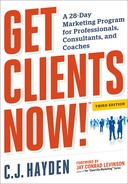Recipe: Calling and Mailing
Sending mail or e-mail and placing calls are activities more typical of the following up stage than when filling the pipeline. This makes sense when you think about the whole purpose of your pipeline-filling activities: to find people you can call or mail, or to get people to contact you. So if you are working on filling the pipeline, you may not have a list of people to contact.
But there are two situations where you may wish to call and mail to help get your pipeline full: contacting new people to see if they might become prospects (more common in business-to-business marketing than when marketing to consumers), and contacting people you already know to stimulate referrals. You’ll find more information about both of these subjects in Chapter 8.
Whenever you contact someone new, the best approach is to call before you mail or e-mail them, and call again after you mail. Even if you don’t reach the person on the first call, you can find out more information from his voice mail or the receptionist, and leave a message to expect an e-mail or letter from you. On your post-mailing call, if you again don’t reach him, you can mention your letter or e-mail, and prompt him to read it if he hasn’t yet.
The purpose of your calls is twofold: to find out if this lead is actually a good prospect for you, and if so, to try to have a sales conversation. Remember that a sales conversation is defined as the time when you find out what your prospects need and tell them what you can do for them. This may happen in a formal presentation or scheduled appointment, or informally, in person, by telephone, or sometimes even by e-mail.
To accomplish your objectives, you will need to ask questions, not just give information. When you reach your prospect on the phone, don’t rattle off a long introduction. Instead, give your name and mention any connection between you; then move immediately into conversation by asking a question. “Do you have a moment to talk about how I can help your company get better results from its training programs?” is a sample opening.
Be considerate when prospects tell you they are too busy to talk, especially if you are calling their cell phone. Tell them you will call another time, and if possible, find out when it might be convenient.
If they have the time to speak with you, be ready with two or three questions that will tell you immediately whether the person you are speaking with has a need for your service. If the need is there, ask for a phone or in-person meeting, or if she has the time, hold the conversation right then. Don’t back away from asking for a meeting by offering to send literature first or referring your prospect to your website. You may never get this person live on the phone again. Only if she declines to meet with you or to take time for a sales conversation by phone should you offer to send something or suggest she visit your site. This is also a polite way to end the conversation if the answers to your qualifying questions indicate this is not a prospect for you.
The people you might be calling if you are trying to fill the pipeline are likely to be those you looked up on a prospect list you purchased or compiled from the Web, a directory, or your social media network, or obtained from a lead source, such as the media or a networking pal. (See “Finding Prospects” below for more information.) The best kind of mail to send folks like this is a personal letter or e-mail. “Personal” means addressed to them by name and mentioning some situation that you have reason to believe exists and that you can help with. If you are using postal mail, you can enclose a brochure or fact sheet, but don’t send a lot of material. Wait for the followup stage to send anything more. And absolutely do follow up.
There’s no hard-and-fast rule about whether postal mail or e-mail is a better choice for a cold contact like this. Sometimes an e-mail will get through to a prospect while a letter might be discarded by a gatekeeper or ignored. On the other hand, many people simply delete all e-mail from people they don’t know. If you are using the call–mail–call sequence, your first call will alert your prospect to look for your e-mail, so he will be less likely to mistake it for an anonymous message sent to thousands of recipients. But with some prospects, only a postal letter will get their attention. You may wish to try both approaches.
When contacting people you already know in order to fill the pipeline, you are hoping to uncover needs they may have, or encourage referrals by reminding them who you are and what you do. Those you contact might be former clients, people you have had sales conversations with in the past who didn’t buy, or networking contacts.
You might choose to get in touch with these people by phone, and place a “what’s new” call. With centers of influence or likely referral partners, you might wish to schedule coffee or lunch. An easy way to contact a larger number of people, though, is by mail or e-mail. Again, personal mailings can have more impact than mass mailings of postcards or newsletters. An article, event announcement, or link to a useful website with a simple “thought you would be interested” note is a friendly and effective variety of reminder.
